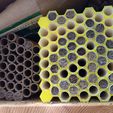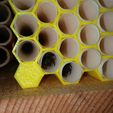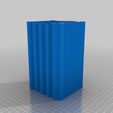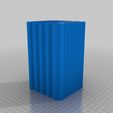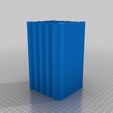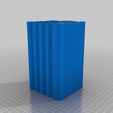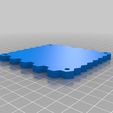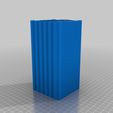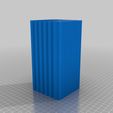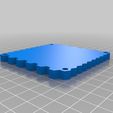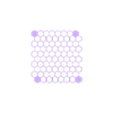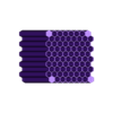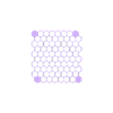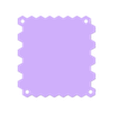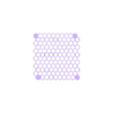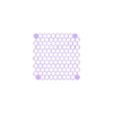These mason bee and leafcutter bee houses need paper inserts to allow for harvesting, cleaning, and storing the cocoons. I recommend using baking parchment paper as it will withstand the elements, won't cause rot or mold, and doesn't have any undesirable chemicals that might be harmful to the bees.
The number printed on the back piece indicates the number of tubes in the block.
Instructional video:
https://www.youtube.com/watch?v=m-Nyg04d8Aw
Cut enough parchment paper for your block, plus a few extras. For mason bee tubes the parchment dimensions are 6.5" x 4". For leafcutter bee tubes the parchment dimensions are 6.5" x 2.5".
Roll paper around a wooden dowel (1/4" for mason bees, 3/16" for leafcutter bees) and insert into back side of block. Leaving approx. 1/2" of rolled paper sticking out the back. Paper should be even with the front side. Fill all holes with rolled paper insert. Fold excess paper down and attach the back piece with screws (#8 x 3/4" pan head sheet metal screws). This closes off the back of the tubes, prevents the paper inserts from falling out, and gives you a handle to pull the inserts out for harvest.
Mason bees and leafcutter bees are solitary bees, easy to care for and manage, and are great pollinators. If you don't know what you're doing with these types of bees I recommend you learn from a local beekeeper or gardener and find some information online or in books on how to care for and keep solitary bees.
A few design variations are available for the block. One without a face pattern, one with a "heart" pattern, one with a "spiral" pattern, and one with a "zigzag" pattern. The patterns are intended to be printed with a different color of plastic than the main block. Choose a contrasting color. (Bees can't see red, it looks like black to them. It's fine to use as a contrasting color against lighter colors, but not with black.) The idea is to change the filament when you get to the pattern layer. This should make it easier for the bees to orient to and find the correct hole they've been working in. My initial printed block used for testing this design was without the face pattern and I observed bees getting confused about which hole to enter. It would take them a few tries but they'd eventually figure it out. The pattern is meant to help speed up this process, but hasn't been fully tested yet.
I tested both the mason bee and leafcutter bee blocks for one season. I had great success with the mason bee block, but not so much with the leafcutter bees. I'm not really sure why things didn't work out well with the leafcutters. It could have been a bad batch of cocoons, or my yard isn't adequate for leafcutters (although all other bees seem to love it), or I just put them out too late in the season, or any number of reasons. I can't necessarily blame the tubes, but I also can't rule it out. So consider all of these blocks, both mason and leafcutter, to be experimental, and you'll be increasing the study sample size by participating in the experiment.
If you use this design please let me know how things work out for you and your bees!
Disassembly and harvesting video:
https://www.youtube.com/watch?v=pRsffOIRtWA
Harvesting video:
https://www.youtube.com/watch?v=loAcJpR7jVI
Harvesting the cocoons in the autumn gives you an opportunity to clean them and inspect for and destroy predatory insects. Store cocoons in a cool place, like your refrigerator (not freezer), through winter so you can better time their hatching in the spring. Please do your research on harvesting mason and leafcutter bee cocoons.

/https://fbi.cults3d.com/uploaders/13603482/illustration-file/9fb01b0a-37d1-4fd6-a19a-4eac71fdc4ee/20180520_120829.jpg)
